Here's My Workshop!
Jim Draper
Rice, WA
Click on any picture to see a larger version.
Today, my shop is one of my favorite places to occupy my time... constructing mostly small cabinets, tables, and bookcases. My passion for woodworking has increased steadily as my skills (especially working with hand tools) have improved. I am a mostly self-taught kind-of-guy, although I have taken a class on the use and sharpening of hand tools from RoseWood Studios some years ago and, more recently, a class from woodworker, Lonnie Bird. Of course, the internet (as in most things) has made so much information available (tools, techniques, schools, materials, etc)—somebody, somewhere has exactly the wood, tool, or technique awaiting your attention.
My shop is attached to our main building on the south side. It has a small but complete guest quarters (where we originally lived when first starting out here) on the west end that we use for our visitors. It is all connected to our main building through a hallway.
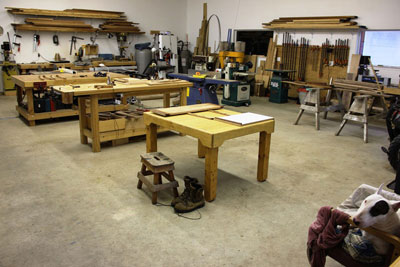
|
A woodworking shop is a very personalized place, as it should be. This is my third shop, and while still not perfect, it does correct some of the omissions and faults in my first efforts. A place where I'm going to be spending a lot of time concentrating on doing my best work needs to be, first and foremost, well-lit, a comfortable temperature, and easy to move around in. With that in mind, I built this shop a little oversized at 28' x 36' w/12' ceilings, (I know, a bit of a luxury for some of us), with lots of light fixtures and windows. I also put numerous electrical outlets (both 110 and 220v) scattered at different levels throughout the building (even on the ceiling!) and on a number of different circuits. Extra insulation in the ceiling keeps the place a comfortable temperature on the dark winter days (I heat with a small wood stove) and yet a cool sanctuary in the summer to escape to on hot days.
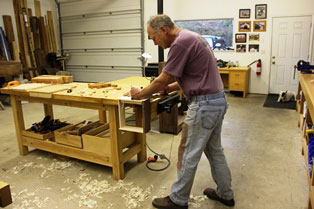
|
I've seen some very beautiful wood projects created in some very Spartan shop environments. On the other hand, sometimes the shop takes on a life of its own, with more time and effort put into perfecting the place than in the pieces that come out of the place. And I have no problem with that. Personally, I like to consider my shop as just another woodworking project--but an ongoing project that I know will never be completely finished. After putting the finishing touches on a long project, sometimes I'll stand back, look over my shop and think "now what did I learn from that process that I can now make some changes to my shop and maybe complete the next project more quickly, efficiently, and perhaps even a little more safely." And sometimes I even make a few of those adjustments, but mostly, I just rush right into the next project.
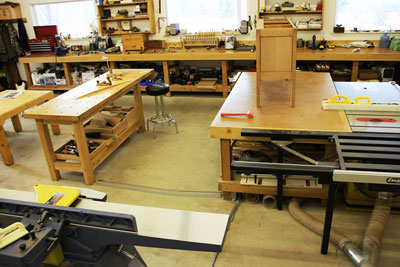
|
The focus of my work area is the triangle formed by the table saw with a large push out/assembly table on one corner, a hand tool workbench on another and a joiner/planer on the third. The hand tool workbench receives natural light from the adjacent window and is also convenient to the sharpening station. I tend to move parts back and forth from the large assembly table to the workbench for fine-tuning with hand tools. I've tried various configurations and this seems to serve my purposes the best. It also gives me the convenience of having my most commonly used tools readily available, without having to carry stock all around the shop. All of the machines are connected to an Oneida Dust Collector.
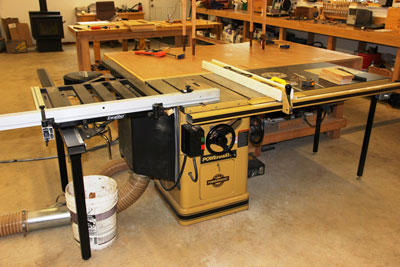
|
My Powermatic PM 66 Table saw and its accompanying large push-out table forms the foundation of my shop machinery. The saw was damaged out of the box and way out of adjustment when I first brought it home. Now I've got it tuned perfectly and I'm quite happy with its performance. I've thought about upgrading to the newer, 5hp model, but the thought of potentially going through all that adjustment process again is a big turn-off. As the table saw is the cornerstone of most of my woodworking projects, having a dependable, high-quality, perfectly adjusted machine is something I consider paramount. Equipped with a
Forrest Woodworker II Blade
(which I regularly remove and scrub the residue off the teeth), the saw just purrs along. I also do a considerable amount of dado work with the saw, including all of my tenon cutting. I do a lot of my assembly work on the large push-out table, and find it especially useful when clamping large boards together.
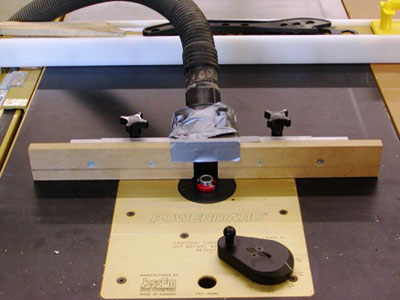
|
The right-side saw extension table also contains a router lift that I really only use for cutting rabbits. At one time, it seems I rounded over every straight edge (or some other decorative edge treatment) on every piece of wood. Now I've become more minimalist, enjoying my sharp edges, especially on vertical pieces. I bought a shaper a couple of years ago, not being able to resist a good deal. But the reality was that it was rarely used and I finally sold it. I've also accumulated a fine collection of routers over the years, but seem to use them less and less as I try to concentrate on improving my hand skills. As much as I love my hand tools, I would be hard pressed to cut tenons by hand and match the speed, accuracy, and reproducibility the table saw (with dado blades) affords.
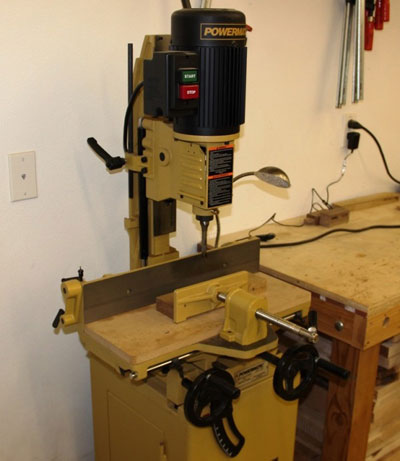
|
My Powermatic 719T Tilt Table Mortiser is a very nice tool that easily does all of my mortising. I upgraded to this from the model 701, which also works well, but the ease of adjustment on the 719T, with the moveable bed controls make this model a joy to use. Whether cutting vertical mortises in a leg or in a wide apron, setup is easy. The rock-solid bed holds the settings well and makes cutting multiple pieces a breeze.
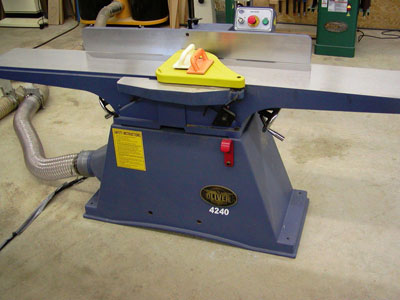
|
A few years ago, I made a decision to sell most of my little-used tools and upgrade some of the tools that I use most frequently. The pull of upgrading my power tools had been felt for sometime and finally became too strong to resist—especially when my local power tool dealer had some incredible deals in the making. The dealer had some new, but excess Oliver machinery available at a great price. Oliver was the standard power tool when I took High School Shop classes, 40 years ago, and was making a sort of resurgence in the tool market. There was a beautiful Oliver 12" table saw available at a screaming deal, but I would have had to rebuild my out-feed bench in order for it to fit, as well as upgrade the wiring and dust collection systems. As the second most-utilized power tool in my shop is the jointer, upgrading to a 10" Oliver 4240 jointer with a Byrd Spiral Cutterhead was a great opportunity. The old 8" Grizzly was adequate for most applications, but the smoothness, power, and long bench on the new Oliver makes it a dream to work with.
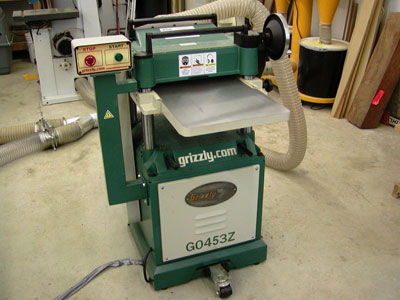
|
I had also been coveting a newer planer for awhile, something beyond the portable bench top models I've been using for so long, and decided to make the move to a larger, stationary model. After some research and cost comparisons, I chose the Grizzly G0453Z 15" with a spiral cutterhead, having been very satisfied with most of the Grizzly tools I've used in the past. The tool arrived ‘rocking' and rolling' in it's shipping crate, with part of it protruding through the side of the plywood box. That should have been my clue to reject the shipment, but mistakenly I took it home, and upon uncrating, found that the top rollers were broken off, as well as other minor damage. It had been shipped on a flimsy, broken pallet and I suspect allowed to topple over somewhere in transit. In my calls, emails, and photographs to Grizzly, I insisted upon delivery of a completely new tool (not knowing what else might be broken or out of alignment) and they finally made it right. This one was shipped stoutly attached to a new pallet and was in perfect condition. After all of that, I can say that the tool is a joy to use and I've been very satisfied with the response from Grizzly.
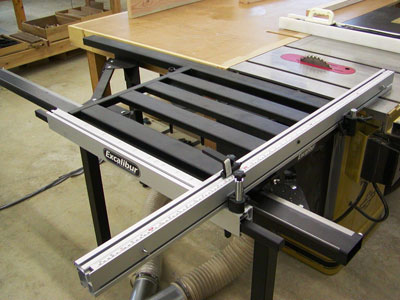
|
I like to use my table saw (instead of the chop saw) and its adjustable miter fence for doing most of my crosscuts, including cutting pieces to an accurate length and cleaning up the shoulders on tenons that I've cut on the tenon jig. As the fence (and width of the table saw top) limits lengths to about 24 inches of accuracy, I've been eyeing a sliding table saw extension for awhile. Seeing the box of a new Excalibur collecting dust for some time at my local dealer, we settled on a good deal for the woodworker and brought the tool home to my shop. The first thing I noticed was that the installation instructions were missing from the box, but an email to General Tools was rewarded promptly with the complete instructions attached.
This was not an easy tool to install. I had to modify several parts of the saw, including using a metal cutting saw to shorten the heavy duty angle iron and channel iron that support the saw's sliding fence. All in all, it took me about 2 days to get the extension installed and accurately adjusted to produce smooth and perfect cutoffs. But, boy was it worth it. I can't say enough about how much I enjoy using the slider, obtaining perfect cuts on pieces as small as a few inches and up to several feet in length. It also allows me to conveniently slide the fence out of the way to rip wider boards or easily pivot the fence (on the post nearest to the saw table) to produce miters-- and then return it accurately by just twisting a couple of knobs.
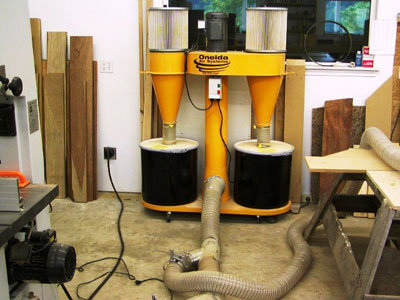
|
All of the machines are also connected to my Oneida dust collector, only having to make a few gate adjustments when switching from one machine to another. I purchased this dust collector directly from the manufacturer and, while doing the assembly, I found the upper manifold had been welded 180 degrees off-center and didn't line up with the base. A call and some emailed-pictures to Oneida, explaining my assembly dilemma, and they promptly sent a correctly manufactured piece (one does wonder about quality control with these companies sometime). The unit works well, providing plenty of suction to remove the chips and dust from the machines. But the filters are not easy to clean and the dust drums fill up quickly.
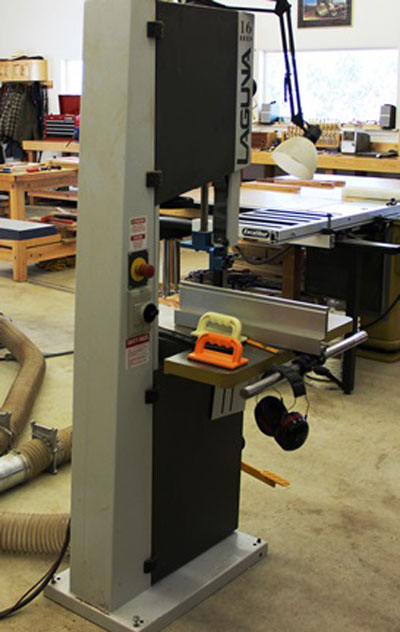
|
My Laguna 16 HD Bandsaw has been more than adequate for my needs, for both cutting curves and resawing. Made in Italy, as are many of Laguna's tools, it is smooth, plenty powerful and has been trouble-free so far. My only complaint was that a little wider of a table would go a long way for ease of use, especially with larger pieces and because I cut all my dovetail tail boards on this saw. Having an extra leaf from my Powermatic Table Saw after adding the sliding table extension, I recently attached the leaf to the side of the band saw to give me a comfortably-large surface for my tail board jig. I also replaced the blade with a
Wood Slicer Resaw Bandsaw Blade
from Highland Woodworking that has made Resawing so much nicer. I can highly recommend these blades.
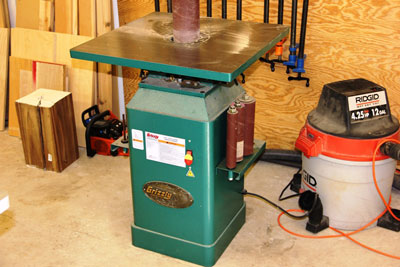
|
While I don't use my spiral sander a lot, when there is the need for smoothing an arc, my Grizzly G1071 performs admirably to accomplish the task. The large table and smooth, vibration-less operation, and large dust-port make this machine quite satisfying to use.
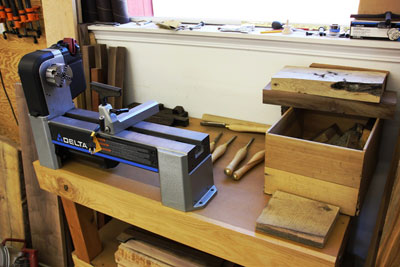
|
This Delta 46-460 12 1/2" Variable-Speed lathe is a rather new addition to my shop, as I come late to the lathe-using game. I really only purchased it to make custom knobs and it has certainly filled that void in my tool lineup. This tool received some rather glowing reviews from FWW and others and it was actually rather difficult to find one that didn't involve back ordering. I finally found one from Amazon and it arrived with a broken on-off switch because of the rather careless packaging. Delta had me take it to a Dewalt Service Center for repair under warranty. It took over 2 months for them to acquire a new switch. I had read complaints about the scarcity of parts for this tool among the reviewers before purchasing, not thinking I would be one those waiting. Now, after spending some time with it, I can say that this is a really nice tool to use, being very smooth and easy to adjust the variable speeds by knob or changing the belt position. I added the
NOVA Chuck
for turning knobs and it has worked flawlessly.
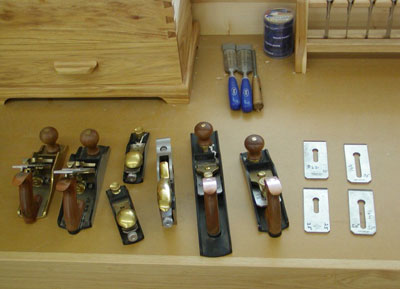
|
Using a sharp, high-quality hand plane to slice away micro-thin layers of a beautiful wood, like cherry, is a labor of pure joy for me. And nothing will quite reveal the true grain character of a species like the new surface exposed from a few strokes of perfectly-tuned plane. On the other hand using a dull, poorly made plane will only lead to frustration, cursing, and an endless amount of sanding. When I started accumulating my planes, I went for the best and have never looked back.
Lie-Nielsen
is one of those rarities — a purely American manufacturing company whose focus on making the highest quality hand tools possible has never waivered. Yes, a bit more of an investment money wise, but the reality is that I don't need a large number of planes—just a few can get most of the work done.
I read an article by Lonnie Bird regarding how just having a couple of low-angle, bevel-up smoothing planes is really all that is required for most planing operations. The key was substituting blades with different secondary bevels in order to match the plane to the grain of the wood being worked—the more figured and courser the grain then the higher the secondary bevel on the blade. As I already had a couple of
Lie-Nielsen Smoothing Planes
(
#62
and
#164
), I ordered 2 new blades for each of them, which they custom ground (at no additional charge) at the secondary bevels of 38 and 50 degrees. And true to Lonnie's word, having these two planes with the optional blades has satisfied most of my needs. My plane selection also includes a
Low-Angle Block Plane
,
Low-Angle Rabbet Plane
(very handy for cleaning up tenons), and a
Shoulder Plane
for close, inside work.
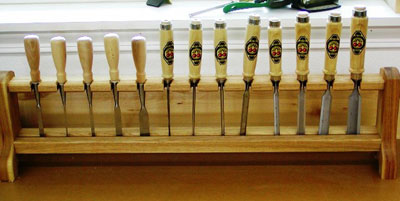
|
I also much prefer my few
Lie-Nielsen Chisels
(those on the left, in the photo) over the larger selection of German-made Two-Cherries. The sides of the Lie-Nielsen Chisels are ground at a single bevel (as compared to the compound bevel on most others), which makes them especially useful for doing the close-in work of hand-cut dovetails. I also like the feel and balance of the smooth hornbeam handles (although I have had trouble keeping them on some of the chisels occasionally).
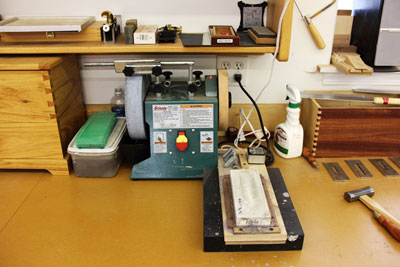
|
My Sharpening Station consists of a Grizzly water-cooled wheel sharpener for creating a concave blade end and an Ohishi combination Water Stone from Lie-Nielsen. These stones cut very quickly and are the best I've found for day-to-day plane and chisel sharpening and can be stored dry. The blade holder for sharpening (behind the stone) is not a very good tool, but
Lie-Nielsen has a video
on making a few modifications that can help significantly. The Grizzly T10097 Sharpener is one of the few Grizzly tools that is only minimally acceptable by my standards. The tool was out of adjustment (and difficult to keep in adjustment) and the stone needed dressing, right out of the box. But for the price it gets the job done.
If you have any questions you can email Jim at
jim@draperjim.com
. You can also visit his website at:
http://www.draperjim.com
Want to see more shops? Check out our
Shops Gallery
, featuring many of the
shops that we have featured in previous editions of Wood News.
Would you like for your shop to appear in this column? We invite you to
SEND US PHOTOS
of your woodworking shop along with captions and a brief history
and description of your woodworking. (Email photos at 800x600 resolution.) Receive a $50 store credit redeemable towards merchandise if we show your shop in a future issue.
